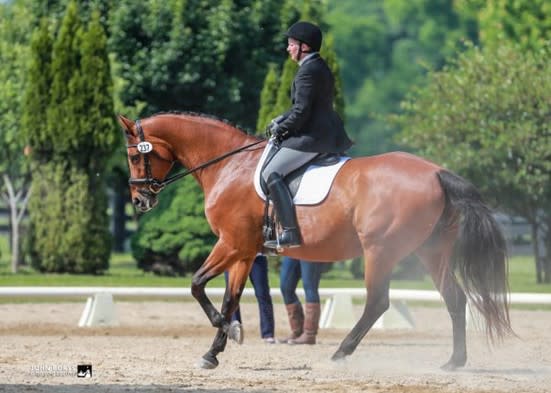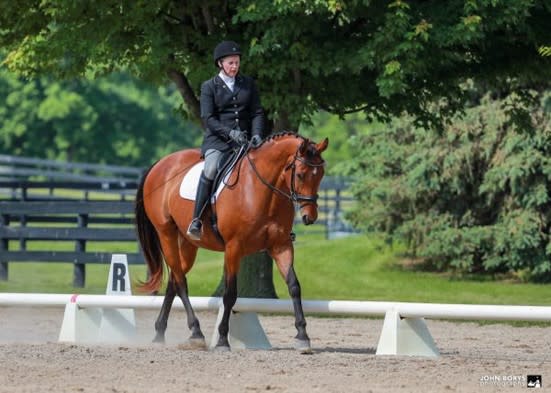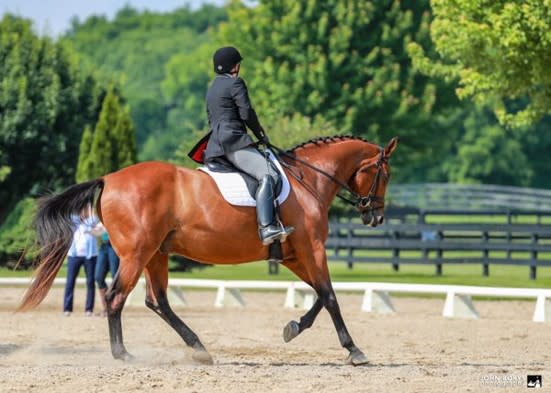Dressage Seat Equitation: Calling All Adult Amateurs!

What to do when you’ve reached a plateau in competitive dressage: try your hand at earning a new Dressage Seat Equitation award from the USDF! I say “new,” but I think this award has been open to all riders—junior/young riders, adult amateurs, and even professionals—for a while now. What’s technically “new” is that adult amateurs earning 70% or higher in a Dressage Seat Equitation class are automatically qualified to compete in the USDF Regional Adult Amateur Equitation Program.
Here’s how Newman and I qualified for regionals and earned both the Elementary (five scores of 65% or higher) and Accomplished (five scores of 72% or higher) Awards.
Score #1: May, Silverwood, 75%
This was my first time riding in a Dressage Seat Equitation class, and I was the only one, which has its pros and cons. It was super hot that day, and when I rode up to the judge’s box, she asked if I would mind if she stayed in there because it was shady. We discussed my demo ride, which I suggested just be a figure eight, with me changing gait at the center after I’d ridden a circle each way. She thought it was a good plan, and I could show her everything she needed to see in just a few minutes.

The judge's comments were:
- Walk: fairly good alignment of ear, shoulder, hip, and heel
- Trot: could be stronger through the core with back flatter, nicely quiet hands
- Canter: needs to open left shoulder for improved bend
Score #2: June, Silverwood, 75%
Again I was the only rider, but this time the judge and her scribe came out to the ring and talked me through First Level Test Two. USEF DR133 describes the rules for this class, in which dress, saddlery, and equipment are equivalent to First Level. The horse and rider should be confirmed at First Level because they must leg yield and lengthen the trot or canter.
The judge's comments were:
- Walk: nice following contact
- Trot: leg could stretch more and be under body more, right leg too far forward, nice line elbow to bit
- Canter: better with heels, legs could be more on (tends to pinch with knees), right leg comes in front of girth
Score #3: July, Lamplight, 76%
This time there were six riders in the class, so the judge came out and ran it like a ring class (for example, Hunter Under Saddle). In the end, she had us line up facing her, and she came and talked to us individually. Here’s what she said to me:

- Slightly leaning back behind vertical at sitting trot and canter
- Reins too long
- Hips could be more open/relaxed/with-the-motion in sitting trot and canter
Dropped Score: August, Fields & Fences, 71.7%
Three-tenths of a point less than what I needed, but by far the most effort! There were two of us this day, and apparently, the judge had trouble deciding who would be first and second because he had us ride for almost 15 minutes. He also gave no comments.
Score #4: September, Silverwood, 79%
I returned to being the only rider, and I thought things had gone well until the judge spent longer giving me feedback than I did riding! Also, I was sure my score would be in the 60s because of how many position flaws she pointed out, so imagine my surprise when she awarded me my highest score! Here were her comments:
- Center of gravity was behind my base of support: I need a stronger front line/core
- Right shoulder low: shift torso to the right
- When canter right, the right shoulder is forward; when canter left, the left shoulder is forward: open shoulder in the direction of lead
- Hands/fingers open
- Keep reins in hand, not across fingers
- Practice with rope
- Imagine holding baby birds
- Ride with a Theraband around both wrists
- Legs sometimes get in front
- Elbows out at the sitting trot
- Knees come up at the sitting trot
Score #5: September, Silverwood, 75%
For my last Dressage Seat Equitation class of the year, I rode by myself again. By now, I was confident I would get at least the 72% I needed to earn the USDF Accomplished Level Award. However, this judge threw me for a loop when she scored me down because I didn’t ask my horse to go forward! He had two more classes that day, so I thought I would conserve his energy. Live and learn!
The judge's comments were:
- Active walk but overall needed to go more forward
- Rider behind balance at times
Reasons to Try Dressage Seat Equitation
I would encourage any horse and rider pair at First Level or above to give the Dressage Seat Equitation classes a try because:
- You get a ton of constructive criticism from a fresh set of eyes.
- They’re WAY less stressful than having to memorize and ride a test.
- You get an award!